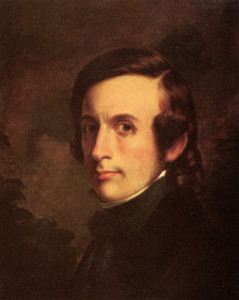Pratt’s talent was discovered by Samuel F. B. Morse when, as a boy of fifteen, Pratt was painting scenes on barn doors. The portrait artist took him to Boston as an errand boy and gave him lessons. Pratt assisted Morse in his work in Charleston, SC, and also sketched in portrait heads for Morse’s large painting of the House of Representatives.
Probably through work in the early days of the National Academy of Design, Pratt and Thomas Cole, two years his senior, met and became friends. They journeyed through the White Mountains in October 1828 gathering sketches for studio paintings. Temperamentally, the two men were very different: Cole was poetic in feeling and wished through his paintings to convey the grandeur of nature as the visible hand of God, while Pratt was factual and pragmatic. These traits are seen in both their paintings and their writings. Pratt was appointed official draftsman to the U.S.-Mexican Boundary Commission, and his works reflect his topographical approach to landscape.
Reference
New Hampshire Scenery
